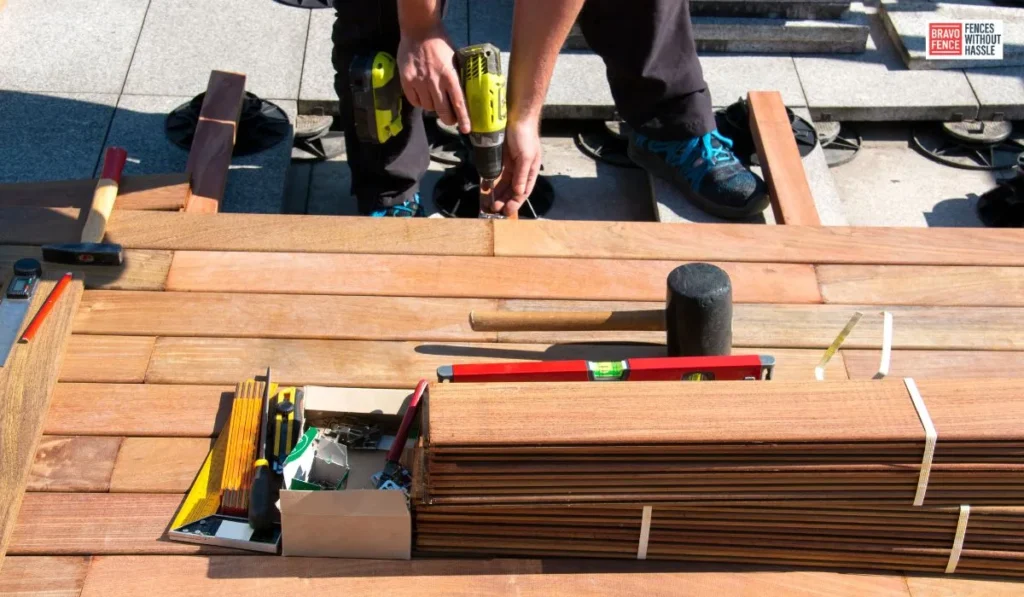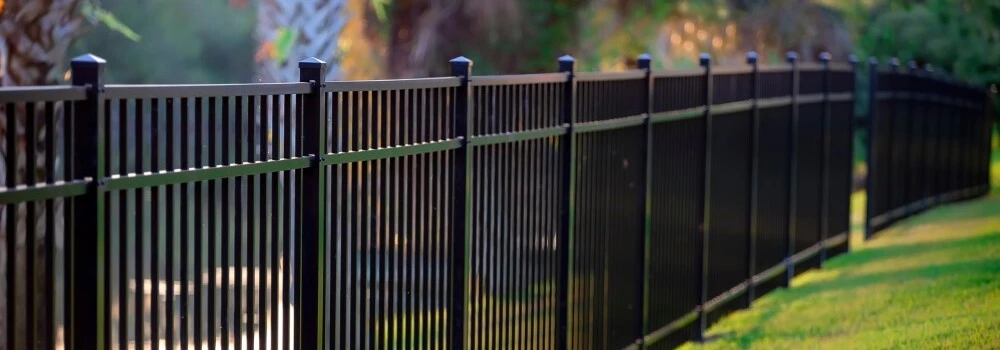
Increase Your Atlanta Home Value with Wood Fence Installation
Installing a wood fence can greatly increase the value of your Atlanta home.
Buyers want homes that are quite aesthetic yet functional.
Thus, an aesthetically pleasing wall is an attractive feature of a property.
Above all, a wood fence is attractive to the eyes, enhances curb appeal, provides required privacy and security, and offers much desirability to both families and individuals.
What is more, natural beauty always compliments a theme of landscaping, ensuring that your house will stand out throughout the entire neighborhood and giving the buyer peace of mind in a new investment.
Wood Fence Installation Preparation
Pre-installment preparation is of extreme importance in terms of a wood fence.
Look and survey the property, keeping in mind that you are researching regulations for permits and the restrictions in the area in which you will be putting your fence.
You might just be able to save yourself the trouble with the neighbors by knowing where your lines are drawn.
Consider the best time to do your project.
The installation of wood fences usually happens during either spring or autumn, when temperatures are not extreme and rainfall is minimal.
This will allow you to have the best conditions both for yourself and the materials that will be used for the installation.
Before You Start
Look for potential local regulations and associations whose guidelines might have effects on a wood fence installation for a property.
Once identified, they may cause wasted time and possibly unnecessary fine charges later on in an installation process.
Think about the purpose of the fence:
Do you need to keep people out or visibility down?
Are you looking for a decorative border?
Knowing your goals and why you want a wall will help narrow down the type and design of wood fencing to meet your needs.
Planning now ensures an easier installation process ahead.
When to Build a Wood Fence
In any wood fence installation, timing is a very important factor.
The best seasons for installation are spring and fall because neither season is overly hot or too cold.
Not only is this installation enjoyable, but the materials also bond well.
Avoid construction during extreme weather conditions, especially heavy rainfall.
This could make the structures unstable.
Always check out the regulations prevailing in that area and also the trends happening in that particular neighborhood so that aesthetic value and functional value are maintained along with maximum utilization of your money.
Tools and Equipment to be used:
Install a wood fence using the right equipment.
It begins with simple tools: a post-hole digger, level, and tape measure.
To secure panels, use a hammer and nails or screws.
Do not forget some gloves and goggles for the safety of the worker while working.
You may require an auger for deeper holes and a concrete mix for stability.
These tools will prove handy to streamline your project and give it a professional finish in no time.
Required Materials
Wood fences necessitate the preparation of necessary materials for their installation.
For installation, these include the lumber prepared with chemicals for application onto posts and panels with wooden fencing boards that should correspond with your style.
Of course, don’t forget to have screws or nails on hand to install them and pour concrete to set the posts.
Depending on your design, you may want additional items such as caps or lattice for a little extra flair.
However, having everything prepared before you begin makes the installation much easier and, of course, more efficient.
Step-by-Step Instructions How To Install a Wooden Fence
Installing a wood fence is already a very exciting project, for it can add beauty and functionality to your property.
Begin by marking out the site where the services will be buried in order not to cause interruptions.
Once marked, you could now stake out the location of your fence and get it exactly as you would want it.
Begin by digging post holes at marked spots as you carefully measure between each hole.
After putting up the posts in place with concrete and base fill, you should attach the panels to them securely.
To top it all off, stain the fence to protect your investment and give your fence a gleaming sheen.
Marking the Site for Buried Services
It is very important to mark the site for a service where buried services lie before you begin digging for your wood fence installation.
Water, gas, or electricity can be just underneath the surface, so do not want any unwarranted surprises that may bring some expensive repairs.
Use a utility locator service, or look up local utility companies to locate the lines so you can mark them without risking damage to essential services in your yard once that is done.
Safety first!
Mark Fence Line
Start by marking where your fence will go.
You can use stakes or flags to mark the corners of your new wood fence.
This will visually show how it fits within your yard and help you get a better feel for the boundaries.
Drawing string lines between the stakes marks a straight edge for an installation.
It should always be taut for it to be accurate, while at this juncture, mark them against any property lines and those established structures so that later one does not have complications in dealing with the neighbors.
Drilling the First Hole for the Post
Install your first post as you mark the area.
Then, dig a hole to stabilize your fence.
Make a hole that is at least 2 feet deep with an auger or post-hole digger.
Ensure that it has a diameter of at least 8-12 inches so space can be allowed for the post and the concrete.
Dig, loosen up the soil, and remove any rocks or debris.
Be careful not to have crooked sides or uneven depth.
All these preparations will make your yard an even and sturdy wood fence.
Taking Measurements to the Second Hole
Once the first post is well secured, you can then measure for the second hole.
You will have to determine the space between posts using a measuring tape depending on your preferred fence style.
The spacing usually falls between six to eight feet.
Mark the location of the next hole with stakes or spray paint.
This will help you ensure that your fence is straight and evenly spaced.
Accuracy in measurement now will save you time and effort later during installation.
Digging the Second Post Hole
Dig the second hole once the first post is securely in position.
Position it correctly relative to the first post using a tape measure.
Consistency in spacing will keep the fence looking professionally done and more attractive.
As you dig, shoot for depth to match or over the first hole.
This gives your fence stability.
Take out rocks or debris as you dig; a clean hole makes an easier installation process down the road.
Adding the Base Fill
Put down the base fill before erecting the posts.
The fill material helps in the proper drainage of water; water drainage helps stabilize the fence.
You may use gravel or crushed stone for the purpose of letting the water flow away from the post.
Pour in a few inches of your chosen base fill into the holes around the post.
You should apply it evenly with the pack-down solidified.
With proper addition, your wood fence will weather storms and shift soils effectively and well in the time to come.
Pouring in Concrete
Pour cement:
Insert your post from the holes, and pour cement.
Mix the cement as indicated in the bag for your best consistency before pouring it to about 2-3 inches above ground level.
Pour the concrete, spread it well and hold it in place to hold the post firmly in position.
Level the fence post and check if it’s upright and level.
You’ll then be making some adjustments until you are sure that everything is all set.
Then, install your fence panel or finish by adding panels.
Installation of Fence Panel
Give the fence panel a careful placement and slide it aligned to the post; flush it against the adjacent posts to achieve an even finish.
You need to ensure that all components are leveled well as you do this.
Once you’ve aligned the panel, prop it in place using scrap wood or stakes for a while.
This temporary bracing will hold it in place as you continue to attach it further.
Take your time here; proper alignment now can save you headaches when finishing touches are added to your beautiful new wood fence.
Attach the Fence Panel
Having placed the posts, it’s now time to put up the fence panels.
Install every panel between the posts, making sure they are in place and perfectly level.
This is important for both aesthetic and structural purposes in the fence.
Now, install or nail down each section using the design you have chosen.
Be careful that everything remains aligned as you progress along the line of panels.
An attached fence has aesthetic appeal but, in addition, will last longer over time.
Staining and Finishing the Fence
Staining and finishing your wood fence can protect the wood and make it look better.
Be sure to choose a top-quality stain that blends in with your home’s exterior and endures long-term durability from the elements.
A deep, rich colour can give the wood its rich natural look.
If using a brush or sprayer, applying a stain will ensure an even coat.
Be sure to let it dry between coats if multiple layers are applied.
This is the most important part of your investment and can make your Atlanta yard really stand out.
How It Increases Home Value
It could improve your curb appeal dramatically.
Homebuyers found that a well-maintained fence provided privacy and some measure of security, making your home more desirable in an otherwise competitive market.
Additionally, a strong wooden fence clearly marks boundaries, which is perfect for families with children or pets.
The functionality of making your yard an extension of your living space also adds to the overall value of your Atlanta home.
Benefits of Wood Fence
A wood fence provides numerous benefits that enhance both functionality and aesthetics.
It maintains privacy, creating a tranquil atmosphere while blocking unwanted views from neighbours or passersby.
Plus, its natural appearance complements many landscaping styles, boosting curb appeal.
Wood fences are also sturdy and can withstand various weather conditions, especially if they are well-prepared.
They can also act as effective sound barriers that dampen the noises outside and create a calm atmosphere in a home.
Once erected with good care, these fences may remain efficient for years and look attractive throughout their lifespan.
Conclusion
Wooden fences in Atlanta will simply transform your place both regarding functionality and aesthetics.
When erect, your outdoor space could turn into a den or private hideout and, at the same time, enhance curbing.
Long-term outcomes may be ensured through quality material and expertise labour.
In fact, a good-quality wood fence will not only increase its value but also enhance the investor’s lifestyle to ensure security is brought to life.
Use this as an opportunity to upgrade and develop your lifestyle and beauty back at home.
FAQs
What is the benefit that you could receive by using a wood fence?
A wood fence enables you to enjoy your private space in the light of being secure and aesthetic appeal.
It enhances your curb appeal and atmosphere in the property.
How long does it take to install a wood fence?
The time scale for the installation varies according to the size and complexity, but for most residential properties, it takes one to three days.
Do I need a permit to install a wood fence in Atlanta?
Yes, do check local laws to ensure you get a permit and possibly even to make sure the fence is tall and not too close to certain properties.
What is a good wood type?
Some of the most widely used woods are cedar and redwood.
That’s because the wood itself doesn’t easily rot.
Most of the time, other preferred choices of wood are pressure-treated pine, simply because it has high durability and is really affordable.
How do I maintain my wooden fence?
The wood is protected from weather damage, and the appearance is maintained by regular cleaning, sealing, or staining every few years.
Tags: Complete Guide to Atlanta Fencing Solutions, Complete Guide to Outdoor Home Enhancements, Everything You Need to Know About Durable Wood Fences, Top Ideas and Insights About Wood Fence Installation, Top Ideas and Insights About Wood Fencing Benefits

